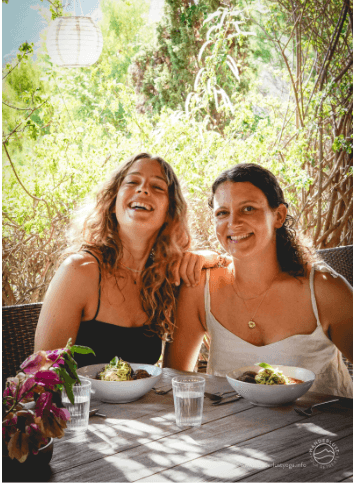What is Meditation and How Do You Do It?
- Constanze

- Apr 4, 2023
- 4 min read
Updated: Jan 9, 2024
Let's talk about meditation

Before I go deeper into the topic of ‘what is meditation’, I want to tell you about my experience, my story, and how I came to yoga.
I started with practising yoga when I was 23 years old, and at that time, practising yoga was for me more or less a workout. I just saw the sporty aspect of the postures and wanted to build muscles and stretch at the same time. The feeling after the class was good, my mind was calm, and I had done my sport for the day.
After a few years of practising yoga, I realised, there is something more than just the physical aspect.
While flowing through different postures, I entered into a meditative state. For me, it felt like my body and mind were at peace, I was calm and focused but at the same time totally in my own world. The outcome was beautiful, but actually, how would I describe this state at this moment?
Sage Patanjali defined yoga as an 8 limb path (ashtanga) in order to overcome all obstacles and to reach limb 9, the ultimate awareness.
The seventh component is Meditation (also called Dhyana in Sanskrit). It means complete physical and mental stillness by means of a strong sense of concentration.
As I told you before, I started with the postures, the third limb of yoga. Okay, wow, I know there is a lot in-between. 😀 But no worries, every different step can bring you forward into your journey to achieve this state I described above. Your journey can start now! “The journey is the destination”, as we all know through a saying attributed to Confucius.
So, what is meditation?

Meditation as a practice, in a narrow sense, means you sit quietly with your back straight, you practise something that calms your mind. The practice of focusing one's mind for a period of time, noticing but not engaging with thoughts, centering yourself.
Meditating brings you into the present moment, away from anything in the future or past. We want to come back to ourselves, into a flow with ourselves. As soon as we are present without noticing, we find ourselves in a meditative form. e.g. during practising the yoga asanas (postures).
Meditation involves getting into a meditative state before meditating and finding a comfortable, steady seat. (Asana = seat; therefore, we practise asanas to get flexible and find this seat to meditate)
On the one hand meditation is a state, on the second level meditation is a practice. As a state, meditation is the state of total emptiness of thought, the state of experiencing oneness. When thoughts are gone, with full awareness, that state is true meditation. That's where we want to get to.
When you sit quietly like this, you have the first step of actual meditation: asana (third limb).
The second step of meditation would be to breathe deeply: pranayama (fourth limb),third step would be to enter a meditative state of mind: pratyahara (fifth limb),
for example, through an affirmation, a prayer, thoughts of benevolence or the visualization of light.
Limb 6 is called Dharana, concentration. You choose a specific meditation topic to meditate on. When you meditate with the technique, you first come into Dhyana (seventh limb), which is the actual state of meditation, where you meditate effortlessly, have an expansion of consciousness, experience joy, experience love, have a clarity of mind that eventually culminates in samadhi (eighth limb), in the superconscious state.
There are different meditation techniques, to start here very simple, I want to describe the mindfulness meditation to find yourself in nothing else than in presence.
How do you practise mindfulness meditation?

After finding a comfortable upright seat, you bring your focus to a specific perception, often times your breath or heartbeat, and try to stay with it.
Even when your thoughts wander around, try to stay with the feeling of pure connection to yourself at this moment.
If it’s helpful, you can also do a scan of your body (bring attention to each part of your body moving from your feet up to your head) to notice any sensations and release any tension you are feeling.
Why start the practice of meditation?
Maybe you ask yourself now, what is the takeaway? Of course, meditation is a practice, not a magic pill. While it can cause incredible changes in your brain and outlook, this doesn’t happen overnight, and it isn’t a cure-all. But nothing in life will come overnight.
Learning to let go of your expectations and simply experience meditation is hard — but it’s also largely the point. The more you practise being at the moment without judgement or expectations, the better you get at it.
Benefits of meditating

The practice can help calm down your sympathetic nervous system, decrease blood pressure, emotional reactivity, stress, anxiety and depression. It can strengthen certain areas of your brain and can increase cognition, memory, learning, attention and self-awareness.
The benefits of meditation are endless, and as soon as you make it a regular part of your life, you won't be able to stop! The impact on your ability to regulate your emotions, self acceptance and the grounding it brings to your life are undeniable.
Want to go deeper into meditation?
If you're just starting out with meditation and want to learn some techniques and go deeper with the practice, why not join us at a yoga and meditation retreat in Tenerife in 2023?
You'll learn new meditation techniques everyday, while soaking up the beautiful atmosphere in the Teno mountains, practicing yoga, eating delicious plant-based food, connecting with like minded people and so much more! Book your place here.




Comments